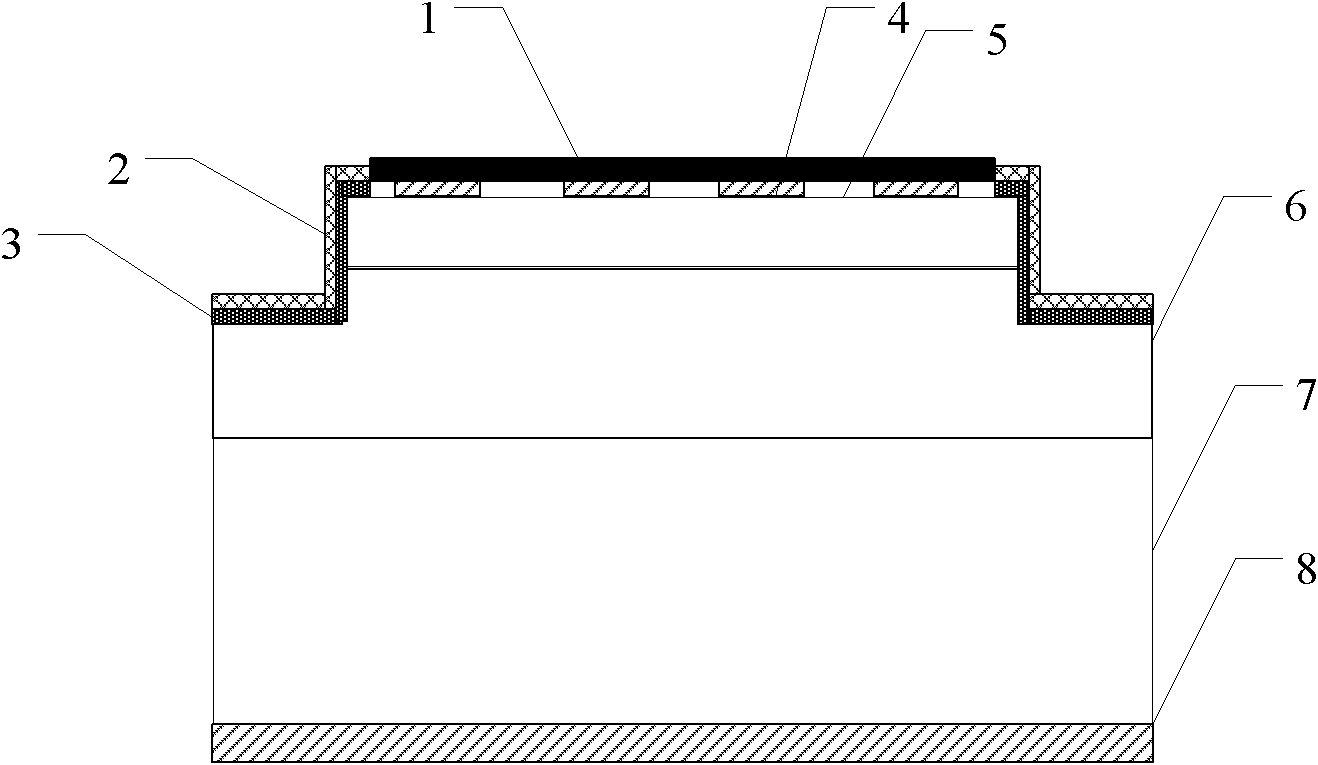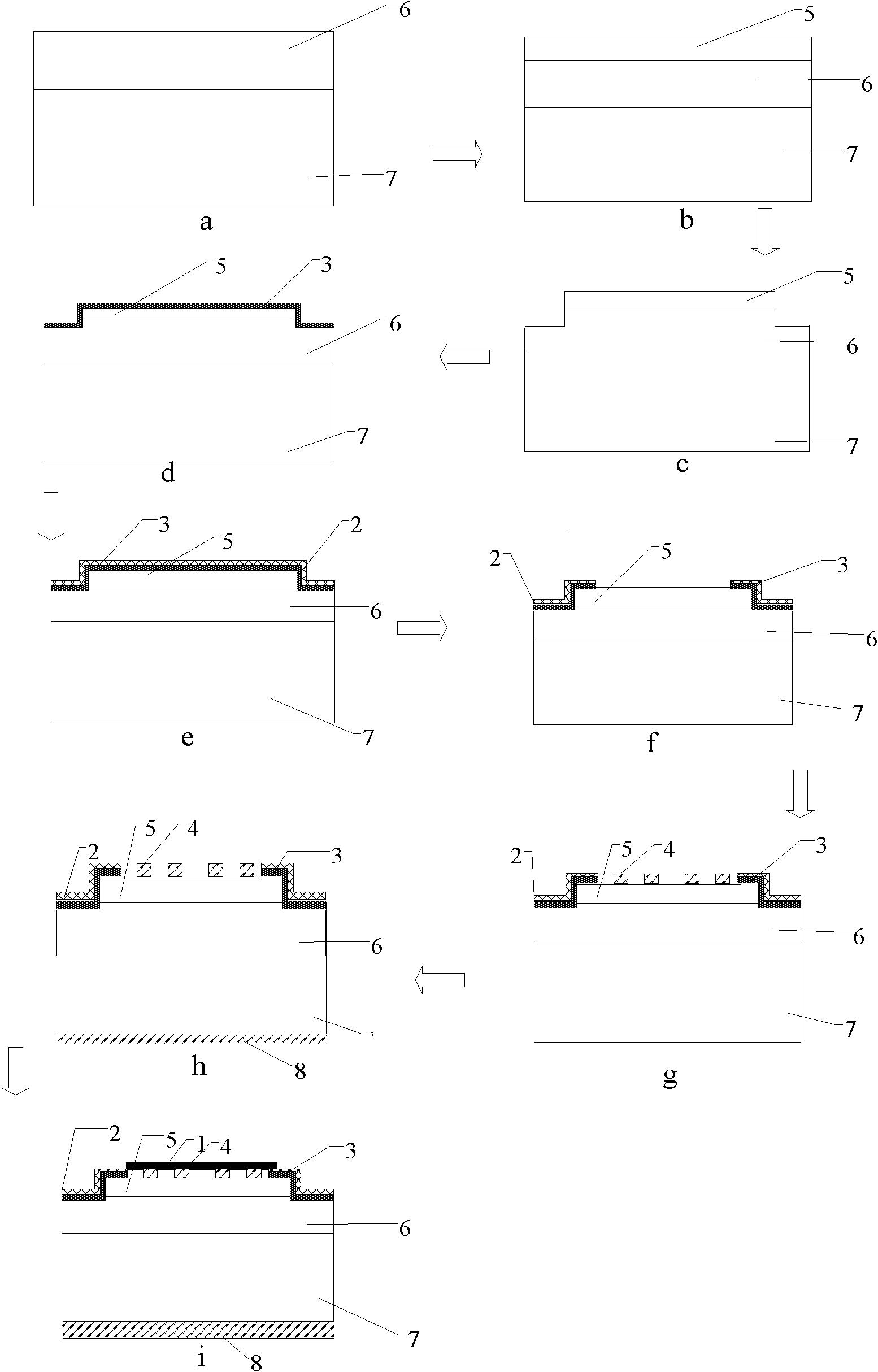SiC ring electrode PIN-type nuclear battery
A nuclear battery and miniature technology, applied in the field of microelectronics, can solve problems such as energy loss and lower energy conversion efficiency, and achieve the effects of reducing blocking effect, improving energy conversion efficiency, and avoiding recombination
- Summary
- Abstract
- Description
- Claims
- Application Information
AI Technical Summary
Problems solved by technology
Method used
Image
Examples
Embodiment 1
[0035] In the first step, a low-doped n-type epitaxial layer is epitaxially grown on a SiC highly doped n-type substrate sample, such as image 3 a.
[0036] The selected doping concentration is 1×10 18 cm -3 After cleaning, the highly doped n-type SiC substrate sample 7 is epitaxially grown on the highly doped n-type SiC substrate sample with a thickness of 3 μm, and the n-type low-doped epitaxial layer 6 doped with nitrogen ions has a doping concentration of 1×10 15 cm -3 , the epitaxy temperature is 1570°C, the pressure is 100mbar, the reaction gas is silane and propane, the carrier gas is pure hydrogen, and the impurity source is liquid nitrogen.
[0037] Step 2: Epitaxial growth of highly doped p-type epitaxial layer, such as image 3 b.
[0038] The p-type epitaxial layer 5 doped with aluminum ions is epitaxially grown on the low-doped epitaxial wafer with a thickness of 0.5 μm, and its doping concentration is 2×10 19 cm -3 , the epitaxy temperature is 1570°C, th...
Embodiment 2
[0056] Step 1: Epitaxial low-doped n-type epitaxial layer on the SiC highly doped n-type substrate sample, such as image 3 a.
[0057] A highly doped n-type SiC substrate sample 7 is selected, and its doping concentration is 5×10 18 cm -3 , after cleaning, the epitaxial growth thickness of the highly doped n-type SiC substrate sample is 4 μm when the epitaxial temperature is 1570 ° C, the pressure is 100 mbar, the reaction gas is silane and propane, the carrier gas is pure hydrogen, and the impurity source is liquid nitrogen. , n-type low-doped epitaxial layer 6 doped with nitrogen ions, and its doping concentration is 3×10 15 cm -3 .
[0058] Step 2: Epitaxial growth of highly doped p-type epitaxial layer, such as image 3 b.
[0059] The epitaxial growth doping concentration on the low-doped epitaxial layer is 2×10 19 cm -3 , with a thickness of 0.3 μm, aluminum ion-doped p-type epitaxial layer 5, the epitaxial temperature is 1570° C., the pressure is 100 mbar, the ...
Embodiment 3
[0077]In step A, a low-doped n-type epitaxial layer is epitaxially grown on a SiC highly-doped n-type substrate sample, such as image 3 a.
[0078] The doping concentration will be selected as 7×10 18 cm -3 After cleaning the n-type highly doped SiC substrate sample 7, the epitaxial growth thickness is 5 μm, and the doping concentration is 5×10 15 cm -3 The n-type low nitrogen-doped ion epitaxial layer 6, the epitaxial growth process conditions are: the epitaxial temperature is 1570°C, the pressure is 100mbar, the reaction gas is silane and propane, the carrier gas is pure hydrogen, and the impurity source is liquid nitrogen.
[0079] Step B: Epitaxial growth of highly doped p-type epitaxial layer, such as image 3 b.
[0080] A p-type epitaxial layer 5 with a thickness of 0.2 μm doped with aluminum ions is epitaxially grown on the low-doped epitaxial layer, and its doping concentration is 5×10 19 cm -3 , the epitaxy temperature is 1570°C, the pressure is 100mbar, the ...
PUM
 Login to View More
Login to View More Abstract
Description
Claims
Application Information
 Login to View More
Login to View More - R&D
- Intellectual Property
- Life Sciences
- Materials
- Tech Scout
- Unparalleled Data Quality
- Higher Quality Content
- 60% Fewer Hallucinations
Browse by: Latest US Patents, China's latest patents, Technical Efficacy Thesaurus, Application Domain, Technology Topic, Popular Technical Reports.
© 2025 PatSnap. All rights reserved.Legal|Privacy policy|Modern Slavery Act Transparency Statement|Sitemap|About US| Contact US: help@patsnap.com



